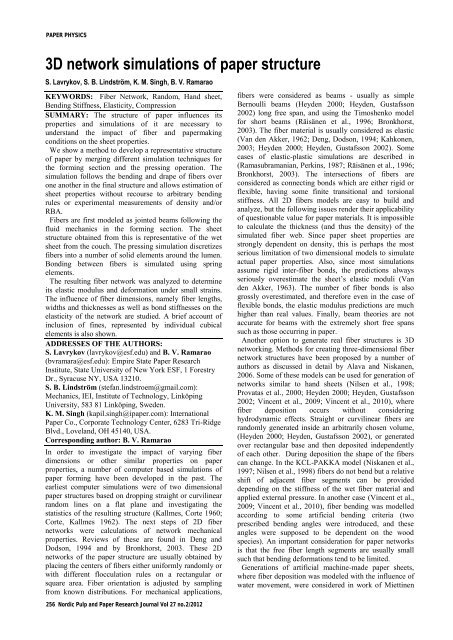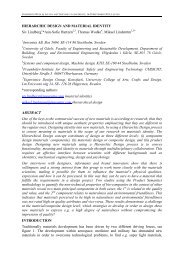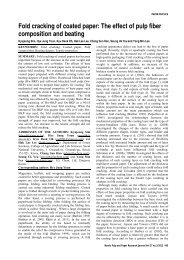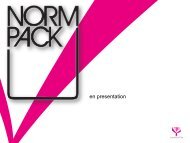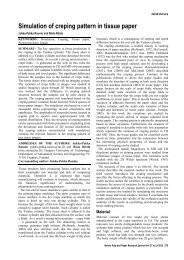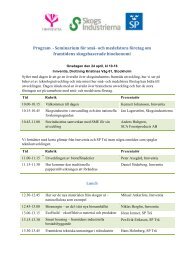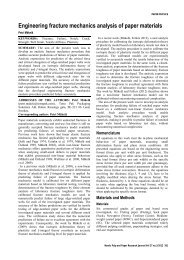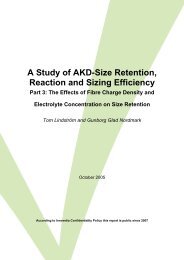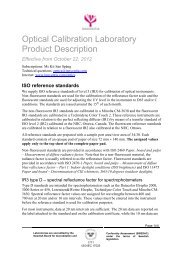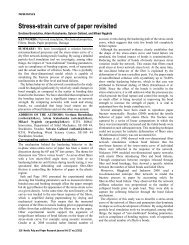3D network simulations of paper structure - Innventia.com
3D network simulations of paper structure - Innventia.com
3D network simulations of paper structure - Innventia.com
Create successful ePaper yourself
Turn your PDF publications into a flip-book with our unique Google optimized e-Paper software.
PAPER PHYSICS<br />
<strong>3D</strong> <strong>network</strong> <strong>simulations</strong> <strong>of</strong> <strong>paper</strong> <strong>structure</strong><br />
S. Lavrykov, S. B. Lindström, K. M. Singh, B. V. Ramarao<br />
KEYWORDS: Fiber Network, Random, Hand sheet,<br />
Bending Stiffness, Elasticity, Compression<br />
SUMMARY: The <strong>structure</strong> <strong>of</strong> <strong>paper</strong> influences its<br />
properties and <strong>simulations</strong> <strong>of</strong> it are necessary to<br />
understand the impact <strong>of</strong> fiber and <strong>paper</strong>making<br />
conditions on the sheet properties.<br />
We show a method to develop a representative <strong>structure</strong><br />
<strong>of</strong> <strong>paper</strong> by merging different simulation techniques for<br />
the forming section and the pressing operation. The<br />
simulation follows the bending and drape <strong>of</strong> fibers over<br />
one another in the final <strong>structure</strong> and allows estimation <strong>of</strong><br />
sheet properties without recourse to arbitrary bending<br />
rules or experimental measurements <strong>of</strong> density and/or<br />
RBA.<br />
Fibers are first modeled as jointed beams following the<br />
fluid mechanics in the forming section. The sheet<br />
<strong>structure</strong> obtained from this is representative <strong>of</strong> the wet<br />
sheet from the couch. The pressing simulation discretizes<br />
fibers into a number <strong>of</strong> solid elements around the lumen.<br />
Bonding between fibers is simulated using spring<br />
elements.<br />
The resulting fiber <strong>network</strong> was analyzed to determine<br />
its elastic modulus and deformation under small strains.<br />
The influence <strong>of</strong> fiber dimensions, namely fiber lengths,<br />
widths and thicknesses as well as bond stiffnesses on the<br />
elasticity <strong>of</strong> the <strong>network</strong> are studied. A brief account <strong>of</strong><br />
inclusion <strong>of</strong> fines, represented by individual cubical<br />
elements is also shown.<br />
ADDRESSES OF THE AUTHORS:<br />
S. Lavrykov (lavrykov@esf.edu) and B. V. Ramarao<br />
(bvramara@esf.edu): Empire State Paper Research<br />
Institute, State University <strong>of</strong> New York ESF, 1 Forestry<br />
Dr., Syracuse NY, USA 13210.<br />
S. B. Lindström (stefan.lindstroem@gmail.<strong>com</strong>):<br />
Mechanics, IEI, Institute <strong>of</strong> Technology, Linköping<br />
University, 583 81 Linköping, Sweden.<br />
K. M. Singh (kapil.singh@i<strong>paper</strong>.<strong>com</strong>): International<br />
Paper Co., Corporate Technology Center, 6283 Tri-Ridge<br />
Blvd., Loveland, OH 45140, USA.<br />
Corresponding author: B. V. Ramarao<br />
In order to investigate the impact <strong>of</strong> varying fiber<br />
dimensions or other similar properties on <strong>paper</strong><br />
properties, a number <strong>of</strong> <strong>com</strong>puter based <strong>simulations</strong> <strong>of</strong><br />
<strong>paper</strong> forming have been developed in the past. The<br />
earliest <strong>com</strong>puter <strong>simulations</strong> were <strong>of</strong> two dimensional<br />
<strong>paper</strong> <strong>structure</strong>s based on dropping straight or curvilinear<br />
random lines on a flat plane and investigating the<br />
statistics <strong>of</strong> the resulting <strong>structure</strong> (Kallmes, Corte 1960;<br />
Corte, Kallmes 1962). The next steps <strong>of</strong> 2D fiber<br />
<strong>network</strong>s were calculations <strong>of</strong> <strong>network</strong> mechanical<br />
properties. Reviews <strong>of</strong> these are found in Deng and<br />
Dodson, 1994 and by Bronkhorst, 2003. These 2D<br />
<strong>network</strong>s <strong>of</strong> the <strong>paper</strong> <strong>structure</strong> are usually obtained by<br />
placing the centers <strong>of</strong> fibers either uniformly randomly or<br />
with different flocculation rules on a rectangular or<br />
square area. Fiber orientation is adjusted by sampling<br />
from known distributions. For mechanical applications,<br />
256 Nordic Pulp and Paper Research Journal Vol 27 no.2/2012<br />
fibers were considered as beams - usually as simple<br />
Bernoulli beams (Heyden 2000; Heyden, Gustafsson<br />
2002) long free span, and using the Timoshenko model<br />
for short beams (Räisänen et al., 1996; Bronkhorst,<br />
2003). The fiber material is usually considered as elastic<br />
(Van den Akker, 1962; Deng, Dodson, 1994; Kahkonen,<br />
2003; Heyden 2000; Heyden, Gustafsson 2002). Some<br />
cases <strong>of</strong> elastic-plastic <strong>simulations</strong> are described in<br />
(Ramasubramanian, Perkins, 1987; Räisänen et al., 1996;<br />
Bronkhorst, 2003). The intersections <strong>of</strong> fibers are<br />
considered as connecting bonds which are either rigid or<br />
flexible, having some finite transitional and torsional<br />
stiffness. All 2D fibers models are easy to build and<br />
analyze, but the following issues render their applicability<br />
<strong>of</strong> questionable value for <strong>paper</strong> materials. It is impossible<br />
to calculate the thickness (and thus the density) <strong>of</strong> the<br />
simulated fiber web. Since <strong>paper</strong> sheet properties are<br />
strongly dependent on density, this is perhaps the most<br />
serious limitation <strong>of</strong> two dimensional models to simulate<br />
actual <strong>paper</strong> properties. Also, since most <strong>simulations</strong><br />
assume rigid inter-fiber bonds, the predictions always<br />
seriously overestimate the sheet’s elastic moduli (Van<br />
den Akker, 1963). The number <strong>of</strong> fiber bonds is also<br />
grossly overestimated, and therefore even in the case <strong>of</strong><br />
flexible bonds, the elastic modulus predictions are much<br />
higher than real values. Finally, beam theories are not<br />
accurate for beams with the extremely short free spans<br />
such as those occurring in <strong>paper</strong>.<br />
Another option to generate real fiber <strong>structure</strong>s is <strong>3D</strong><br />
<strong>network</strong>ing. Methods for creating three-dimensional fiber<br />
<strong>network</strong> <strong>structure</strong>s have been proposed by a number <strong>of</strong><br />
authors as discussed in detail by Alava and Niskanen,<br />
2006. Some <strong>of</strong> these models can be used for generation <strong>of</strong><br />
<strong>network</strong>s similar to hand sheets (Nilsen et al., 1998;<br />
Provatas et al., 2000; Heyden 2000; Heyden, Gustafsson<br />
2002; Vincent et al., 2009; Vincent et al., 2010), where<br />
fiber deposition occurs without considering<br />
hydrodynamic effects. Straight or curvilinear fibers are<br />
randomly generated inside an arbitrarily chosen volume,<br />
(Heyden 2000; Heyden, Gustafsson 2002), or generated<br />
over rectangular base and then deposited independently<br />
<strong>of</strong> each other. During deposition the shape <strong>of</strong> the fibers<br />
can change. In the KCL-PAKKA model (Niskanen et al.,<br />
1997; Nilsen et al., 1998) fibers do not bend but a relative<br />
shift <strong>of</strong> adjacent fiber segments can be provided<br />
depending on the stiffness <strong>of</strong> the wet fiber material and<br />
applied external pressure. In another case (Vincent et al.,<br />
2009; Vincent et al., 2010), fiber bending was modelled<br />
according to some artificial bending criteria (two<br />
prescribed bending angles were introduced, and these<br />
angles were supposed to be dependent on the wood<br />
species). An important consideration for <strong>paper</strong> <strong>network</strong>s<br />
is that the free fiber length segments are usually small<br />
such that bending deformations tend to be limited.<br />
Generations <strong>of</strong> artificial machine-made <strong>paper</strong> sheets,<br />
where fiber deposition was modeled with the influence <strong>of</strong><br />
water movement, were considered in work <strong>of</strong> Miettinen
PAPER PHYSICS<br />
et al. 2007; Switzer et al. 2004; Lindström, Uesaka 2008.<br />
Pulp fibers were modeled as multilink chains <strong>of</strong> rigid<br />
cylindrical segments with circular cross-section,<br />
immersed into Newtonian liquid. Fiber chains can bend<br />
and twist due to joints between segments. Different cases<br />
<strong>of</strong> liquid motion were considered, including simple<br />
drainage under gravity and external pressure, (see<br />
Miettinen et al. 2007; Switzer et al. 2004), and <strong>com</strong>plex<br />
water movement in different sections <strong>of</strong> roll-blade<br />
formers, (Lindström, Uesaka 2008; Lindstrom et al.,<br />
2009). These models suffer some disadvantages such as<br />
the limitations <strong>of</strong> rigid segments which do not permit the<br />
same fiber bending, the output <strong>network</strong>s have low density<br />
and higher thickness. However, these methods can be<br />
used for generating pulp webs <strong>of</strong> low consistency, and<br />
thus can simulate forming situations corresponding to the<br />
wet web before the wet pressing section in the <strong>paper</strong><br />
machine.<br />
The main goal <strong>of</strong> the present work is to develop a<br />
numerical approach to build a <strong>3D</strong> artificial hand sheet<br />
and machine sheet fiber <strong>network</strong>s with prescribed<br />
thickness and apparent density, consisting <strong>of</strong> collapsed<br />
and non-collapsed fibers, fines and fillers. We can take a<br />
simulated <strong>structure</strong> made by using multilink chains <strong>of</strong><br />
rigid cylindrical segments as fibers and abstract the <strong>3D</strong><br />
<strong>structure</strong> <strong>of</strong> the formed <strong>paper</strong> sheet. The abstraction is by<br />
using the center lines <strong>of</strong> the fibers and redecorating their<br />
thicknesses and widths to develop a fiber model with<br />
prismatic elements <strong>com</strong>prising the fibers. The fibers are<br />
also considered to be hollow to allow for the lumens and<br />
can be <strong>com</strong>pressed in a wet pressing simulation to<br />
generate a ‘final’ <strong>structure</strong>. In the following, we will<br />
describe our method <strong>of</strong> generating the <strong>paper</strong> <strong>structure</strong> and<br />
show how it is applied to a random ‘handsheet’ <strong>structure</strong><br />
and a realistic, simulated sheet formed using a twin wire<br />
roll former with blades. The <strong>structure</strong>s are then analyzed<br />
for their mechanical properties (in this case, the elastic<br />
modulus).<br />
Fiber <strong>network</strong> Generation<br />
Hand Sheet Formation<br />
A set <strong>of</strong> objects is defined for the simulation, which<br />
includes objects <strong>of</strong> three types: fibers, fines or fillers.<br />
These are characterized by their geometrical parameters<br />
which include length, width and thickness, their<br />
distributions and type <strong>of</strong> cross-section i.e. collapsed or<br />
non-collapsed, as in Fig 1. Fiber type 1a has only one<br />
finite element in thickness direction. This type was<br />
usually used to describe fines and fillers. Fiber types 1b<br />
and 1c have arbitrary number <strong>of</strong> elements in all three<br />
directions (length, width, thickness). Non-collapsed fiber<br />
type 1d has always one element in the thickness <strong>of</strong> fiber<br />
wall and arbitrary number <strong>of</strong> elements in other two<br />
directions. It is possible to include curl and kink <strong>of</strong> fibers<br />
by suitable modifications <strong>of</strong> these elementary <strong>structure</strong>s,<br />
although this was not implemented in the current<br />
simulation.<br />
The first step <strong>of</strong> the simulation is to generate an initial<br />
<strong>structure</strong>. Handsheet formation can be simulated by<br />
simply placing fibers (or objects) randomly in space<br />
(a)<br />
(c)<br />
(b)<br />
(d)<br />
Fig 1. Configurations <strong>of</strong> fibers used in the model<br />
Frequency<br />
0,45<br />
0,40<br />
0,35<br />
0,30<br />
0,25<br />
0,20<br />
0,15<br />
0,10<br />
0,05<br />
0,00<br />
Hardwood Pulp<br />
0,5 0,9 1,4 2,0 2,7<br />
Fiber length, mm<br />
Fig 2. Examples <strong>of</strong> fiber length distributions for s<strong>of</strong>twood and<br />
hardwood pulps<br />
according to their distribution in the furnish. An example<br />
<strong>of</strong> such distributions for hard wood and s<strong>of</strong>t wood pulps<br />
are shown in Fig 2.<br />
The second step is location <strong>of</strong> centers <strong>of</strong> objects in Z<br />
direction. Each new object has Z coordinate taking into<br />
account all objects already generated and located below<br />
this particular one. All points <strong>of</strong> such line have the same<br />
Z-coordinate.<br />
The third step is the generation <strong>of</strong> finite element grid in<br />
each object according to type <strong>of</strong> object cross-section and<br />
its dimensions. The topology <strong>of</strong> finite elements (shape<br />
and local numbering <strong>of</strong> nodes) should correspond to finite<br />
element s<strong>of</strong>tware used in the following steps. In our case<br />
this was the 8-node hexahedron solid element in the LS-<br />
DYNA Explicit program.<br />
Nordic Pulp and Paper Research Journal Vol 27 no.2/2012 257
PAPER PHYSICS<br />
Fig 4. ZD view <strong>of</strong> simulated sample <strong>structure</strong> after forming in<br />
<strong>paper</strong> machine<br />
z max<br />
z<br />
z caliper<br />
Fig 3. An example <strong>of</strong> initial configuration <strong>of</strong> fiber <strong>network</strong> (all<br />
four fiber configurations and filler particles are presented)<br />
The fourth step is trimming out the part <strong>of</strong> finite element<br />
grid outside prescribed sample dimensions. A sample <strong>of</strong><br />
the finite element <strong>network</strong> generated after the fourth step<br />
is shown in Fig 3.<br />
And the fifth, the last step, is the calculation <strong>of</strong> fiber<br />
deposition velocities. All points <strong>of</strong> each particular object<br />
have the same initial velocity in vertical direction. The<br />
velocity is calculated from the deposition height and<br />
deposition time.<br />
Machine Sheet Formation<br />
This method <strong>of</strong> fiber <strong>network</strong> generation is described in<br />
detail by Lindström, Uesaka, 2008. Fibers are represented<br />
as sets <strong>of</strong> rigid segments connected by joints with bend<br />
and torsion stiffness. Mass and moment <strong>of</strong> inertia <strong>of</strong><br />
segments correspond to solid circular cylinders. Initially<br />
all fibers are generated randomly inside a prescribed<br />
volume, which is filled by a viscous in<strong>com</strong>pressible fluid.<br />
The motion <strong>of</strong> the fluid is governed by the threedimensional<br />
Navier–Stokes equations. Equations <strong>of</strong><br />
motion <strong>of</strong> fiber segments includes inertia forces,<br />
hydrodynamic drag forces from moving liquid and fiberto-fiber<br />
contact forces. The slurry is running through<br />
different sections <strong>of</strong> <strong>paper</strong> machine, where different<br />
boundary conditions are applied (Lindström, Uesaka,<br />
2008; Lindstrom et al., 2009). The final low consistency<br />
pulp mat is used as initial input data for the <strong>network</strong><br />
<strong>com</strong>pression model. Each circular fiber is replaced by the<br />
collapsed or non-collapsed fiber, Fig 1, and is divided<br />
into a set <strong>of</strong> finite elements. A mechanical material model<br />
(elastic, elastic-plastic, visco-elastic-plastic) is assigned<br />
for each particular fiber. The wet fiber flexibility is a<br />
fiber parameter that has been investigated extensively in<br />
the past and can be used to determine a representative<br />
fiber modulus. Since wet fibers are substantially plastic, it<br />
is necessary to define plasticity parameters in addition to<br />
the elasticity. Fibers are anisotropic and their deformation<br />
is considerably <strong>com</strong>plex. However, for an initial<br />
simulation such as this, we used a simple isotropic<br />
bilinear elastic-plastic model with the modulus<br />
determined from the wet fiber flexibility data in the<br />
literature [Paavilainen, Luner, 1986; Abitz et al., 1985].<br />
An example <strong>of</strong> machine-generated <strong>network</strong> is shown in<br />
Fig 4.<br />
258 Nordic Pulp and Paper Research Journal Vol 27 no.2/2012<br />
t load t rest t unload<br />
Fig 5. Upper rigid plate movement history during mat<br />
<strong>com</strong>pression<br />
Fiber <strong>network</strong> Compression<br />
The simulation <strong>of</strong> fiber mat <strong>com</strong>pression was performed<br />
with the explicit finite element method, [see Zhong 1993<br />
and Hallquist 2005]. We used LS-DYNA, a program for<br />
Nonlinear Dynamic Analysis <strong>of</strong> Structures in Three<br />
Dimensions, Version 971 (Hallquist 2005). The 8 node<br />
hexahedron elements with three displacements in each<br />
node were used to represent fiber <strong>network</strong>. The central<br />
finite difference scheme was used for the numerical<br />
integration <strong>of</strong> the equations <strong>of</strong> motion. Fiber-to-fiber<br />
interactions during simulation were calculated from<br />
balance <strong>of</strong> nodal inertia forces, external forces, internal<br />
forces and contact forces. All contact couples were found<br />
automatically during simulation. (This method <strong>of</strong> contact<br />
handling was made possible by using a keyword<br />
*CONTACT_AUTOMATIC_GENERAL).<br />
To obtain the fiber mat with prescribed thickness and<br />
density, the <strong>network</strong> was <strong>com</strong>pressed between two rigid<br />
plates. The non-moving plate is located below the<br />
previously generated fiber <strong>network</strong>. The moving plate<br />
with prescribed motion in vertical direction (Fig 5) is<br />
initially located on the top <strong>of</strong> the mat. Fiber settling and<br />
<strong>com</strong>pression are performed during a loading time ,<br />
which was equal to 1-2 ms. A stabilization time is<br />
need to decrease dynamic effects in the <strong>com</strong>pressed fiber<br />
mat which was generally set to 1 ms. An unloading time<br />
is also needed to remove the upper plate and to<br />
give the fiber mat possibility to expand in thickness<br />
direction due to internal stresses in fibers. The unloading<br />
time was 0.1-1.0 ms usually.<br />
The results <strong>of</strong> some <strong>3D</strong> <strong>network</strong> <strong>simulations</strong> are<br />
presented in Fig 6-9. The initial fibers configuration from<br />
Fig 3 after <strong>com</strong>pression is shown in Fig 6. A larger scale<br />
model with about 1500 fiber <strong>of</strong> the mixture <strong>of</strong> hardwood<br />
and s<strong>of</strong>twood pulps is presented in Fig 7. Results <strong>of</strong><br />
simulation <strong>of</strong> fiber <strong>network</strong> with high content <strong>of</strong> mineral<br />
filler (25% weight fraction) are shown in Fig 8 and 9. A<br />
layer created by fillers is observed in the pictures. The<br />
example <strong>of</strong> machine-made fiber <strong>network</strong> after<br />
<strong>com</strong>pression is shown in Fig 10. The colors serve to<br />
differentiate the fibers in the <strong>network</strong>.<br />
t
PAPER PHYSICS<br />
Fig 10. Simulated machine-made sample after <strong>com</strong>pression<br />
Fig 6. Fiber <strong>network</strong> from Fig. 3 after <strong>com</strong>pression<br />
ΔX<br />
ΔX<br />
L<br />
Fig 7. The sample with 50% mixture <strong>of</strong> s<strong>of</strong>twood and hardwood<br />
pulps<br />
Fig 8. Fiber <strong>network</strong> with high filler content – an example <strong>of</strong><br />
coating simulation<br />
Fig 9. Filler particles distribution in the fiber mat during coating<br />
formation<br />
Fig 11. Tensile test for elastic modulus calculations<br />
Fiber Network Applications<br />
Calculation <strong>of</strong> Apparent Elastic Modulus<br />
The apparent elastic modulus is calculated the same way<br />
as usually calculated from the physical tensile test. The<br />
sample length should be at least 1.2 times bigger than the<br />
longest fiber in the <strong>network</strong>, as re<strong>com</strong>mended in Heyden<br />
2000. The example <strong>of</strong> such sample is presented in Fig 11<br />
(sample length is 5 mm, width is 1 mm). Material <strong>of</strong><br />
fibers is isotropic elastic. Mechanical properties <strong>of</strong> single<br />
fibers <strong>of</strong> different dry wooden species can be found in<br />
(Bronkhorst 2003; Page et al. 1977; Katz et al 2008).<br />
Before the solution <strong>of</strong> elastic boundary-value problem,<br />
the <strong>network</strong> should be analyzed and bonds between fibers<br />
should be set up. A contact couple can be defined only<br />
between two elements which belong to two different<br />
fibers. From one to four links (bonds) may be set up in<br />
one contact couple. The stiffness <strong>of</strong> each bond is<br />
calculated from the value <strong>of</strong> contact area (overlapped area<br />
<strong>of</strong> two contact surfaces) and bonding stiffness,<br />
experimentally found by Thorpe et al. 1976. The average<br />
maximum shear stress reported by Thorpe et al. 1976 and<br />
Perkins 2001, for the holocellulose bond was<br />
corresponding to an average maximum strain<br />
. The bond stiffness parameter is obtained<br />
as<br />
and is equal to the<br />
spring force between each pair <strong>of</strong> bonding nodes. Fibers<br />
not bonded to other fibers <strong>of</strong> the <strong>network</strong> are eliminated<br />
from consideration. To solve the elastic problem, the<br />
kinematic boundary conditions should be applied to the<br />
finite element grid. Prescribed displacements are assigned<br />
to the nodes located on clamped area on the top and the<br />
bottom surfaces from two opposite sides <strong>of</strong> the sample,<br />
Fig 11.<br />
After solution <strong>of</strong> elastic problem, nodal displacements<br />
are used for calculation <strong>of</strong> strain and stress distributions<br />
in finite elements.<br />
Integration <strong>of</strong> stresses over element’s area in some<br />
sample cross-sections gives average force and average<br />
Nordic Pulp and Paper Research Journal Vol 27 no.2/2012 259
PAPER PHYSICS<br />
Elastic Modulus, GPa<br />
7,0<br />
6,0<br />
5,0<br />
4,0<br />
3,0<br />
2,0<br />
1,0<br />
S<strong>of</strong>twood<br />
Hardwood<br />
0,0<br />
0,09 0,11 0,13 0,15<br />
Caliper, mm<br />
Fig 12. Elastic modulus <strong>of</strong> <strong>network</strong>s <strong>of</strong> s<strong>of</strong>twood and hardwood<br />
pulps<br />
Elastic Modulus, GPa<br />
4,0<br />
3,0<br />
2,0<br />
1,0<br />
0,0<br />
5,0 7,5 10,0 12,5 15,0<br />
Fiber Thickness, µm<br />
Fig 13. Elastic modulus <strong>of</strong> simulated <strong>network</strong> as a function <strong>of</strong><br />
fiber thickness<br />
Elastic Modulus, GPa<br />
4,0<br />
3,0<br />
2,0<br />
1,0<br />
0,0<br />
10,0 15,0 20,0 25,0 30,0 35,0 40,0<br />
Fiber Width, µm<br />
Fig 14. Elastic modulus <strong>of</strong> simulated <strong>network</strong> as a function <strong>of</strong><br />
fiber width<br />
Elastic Modulus, GPa<br />
6,0<br />
5,0<br />
4,0<br />
3,0<br />
2,0<br />
1,0<br />
0,0<br />
0,0 0,3 0,5 0,8 1,0 1,3 1,5 1,8<br />
Fiber Length, mm<br />
Fig 15. Influence <strong>of</strong> bond stiffness on elastic modulus <strong>of</strong> fiber<br />
<strong>network</strong>s<br />
0.01<br />
0.05<br />
0.1<br />
0.2<br />
0.3<br />
0.4<br />
0.5<br />
Elastic Modulus, GPa<br />
6,00<br />
5,95<br />
5,90<br />
5,85<br />
5,80<br />
0,5 1,0 1,5 2,0 2,5<br />
Sample Length/Max Fiber Length<br />
Fig 16. Influence <strong>of</strong> sample length on elastic modulus <strong>of</strong> 60 gsm<br />
fiber <strong>network</strong> (fiber length 2 mm, sheet caliper 0.1 mm)<br />
stress in the sample. The strain value is equal to ratio <strong>of</strong><br />
prescribed displacement to the length <strong>of</strong> free span<br />
(distance between clamps), so the apparent elastic<br />
modulus is found. Fig 12 shows the elastic modulus for<br />
sample <strong>network</strong>s <strong>of</strong> s<strong>of</strong>twood and hardwood pulps with<br />
length distributions shown in Fig 2. The modulus is<br />
shown as a function <strong>of</strong> sheet caliper corresponding to<br />
different wet pressing levels. We observe that the<br />
modulus increases as the caliper is decreased, i.e. the<br />
sheet is densified by wet pressing to different levels. It<br />
can also be seen that the s<strong>of</strong>twood fiber <strong>network</strong> shows<br />
higher modulus as <strong>com</strong>pared to the hardwood fibers. This<br />
result clarifies the impact <strong>of</strong> fiber length on sheet<br />
modulus. In order to evaluate the influence <strong>of</strong> some fiber<br />
parameters including fiber width, fiber thickness and<br />
bonding stiffness, on apparent tensile elastic modulus <strong>of</strong><br />
fiber mat we conducted more <strong>simulations</strong> for fiber mats<br />
with the same basis weight 60 gsm and the same material<br />
properties. The results are shown in Figs 12-15 and in<br />
Table 1.<br />
Fig 13 and Fig 14 show that the elastic modulus<br />
decreases with increased thickness (evaluated at constant<br />
caliper). Increasing thickness results in lesser fibers in the<br />
sheets, resulting in the lower values observed. Fig 15<br />
shows the influence <strong>of</strong> the bond stiffness; increased<br />
stiffness shows increases in the elastic modulus.<br />
However, the increase quickly saturates and when the<br />
bond stiffness increases beyond 0.3, gains in the modulus<br />
are small.<br />
The size <strong>of</strong> the <strong>network</strong> for simulation <strong>of</strong> the elastic<br />
properties should be sufficiently large such that the<br />
effects <strong>of</strong> singular fibers spanning a large portion <strong>of</strong> the<br />
<strong>network</strong> are minimized. In order to investigate this<br />
effect, we carried out <strong>simulations</strong> <strong>of</strong> the elastic modulus<br />
with increasing <strong>network</strong> length (denoted as sample size)<br />
keeping fiber length a constant. Fig 16 shows the results<br />
for fibers <strong>of</strong> length 2mm. The simulation result for the<br />
elastic modulus is independent <strong>of</strong> the <strong>network</strong> size for<br />
<strong>network</strong>s greater than 1.5 fiber lengths. Fig 17 shows a<br />
graph <strong>of</strong> the wet pressing pressure as a function <strong>of</strong> mat<br />
density for an example s<strong>of</strong>twood and hardwood fibers.<br />
These are representative calculations indicating that for a<br />
given wet pressing pressure, the s<strong>of</strong>twood sheets are<br />
more densified than the hardwoods. The calculations<br />
serve as illustrative cases since the parameters chosen for<br />
the fibers were arbitrary.<br />
260 Nordic Pulp and Paper Research Journal Vol 27 no.2/2012
PAPER PHYSICS<br />
Table 1. Properties <strong>of</strong> fibers and simulated 60 gsm sheets, 1x2 mm sample (20F represents fines, fiber objects consisting <strong>of</strong> single<br />
elements).<br />
Parameter<br />
S<strong>of</strong>twood pulp Mix 1<br />
Mix 2<br />
Mix 3 Hardwood pulp<br />
0HW+100SW 50HW+50SW 64HW+16SW+20F 80HW+20SW 100HW+0SW<br />
Fiber Length (Avg.), mm 3.0 2.0 1.2 1.4 1.0<br />
Fiber Width (Avg.), μm 24 24 24 24 24<br />
Elastic Modulus Fiber, GPa 10 10 10 10 10<br />
Caliper, μm 100 100 100 100 100<br />
Number <strong>of</strong> fibers 612 783 1162 952 1111<br />
Elastic Modulus <strong>of</strong> sheet, GPa 6.433 5.920 4.309 4.278 2.959<br />
Stiffness (mN·m), simulated 0.536 0.493 0.359 0.356 0.246<br />
Stiffness (mN·m), experiment<br />
(Lavrykov et al., 2010)<br />
0.763 0.703 0.693<br />
Wet Pressing Pressure, MPa<br />
60,0<br />
50,0<br />
40,0<br />
30,0<br />
20,0<br />
10,0<br />
S<strong>of</strong>twood<br />
Hardwood<br />
0,0<br />
0,4 0,5 0,6 0,7 0,8<br />
Density, g/cm 3<br />
Fig 17. Pressure as a function <strong>of</strong> mat density<br />
Table 1 below shows the results <strong>of</strong> <strong>simulations</strong> <strong>of</strong> 60<br />
gsm sheets <strong>com</strong>posed <strong>of</strong> a mix <strong>of</strong> hardwood and<br />
s<strong>of</strong>twood pulps in different ratios along with a portion <strong>of</strong><br />
the fines. Note that the mixes are shown in number<br />
fractions (not mass) as is usual for experimental data. The<br />
simulation results show that the sheet modulus is a strong<br />
function <strong>of</strong> the s<strong>of</strong>twood content, increasing in magnitude<br />
as this increases. An important parameter, the sheet<br />
stiffness was also evaluated and shown to be a strong<br />
function <strong>of</strong> the s<strong>of</strong>twood content in the pulp. The final<br />
rows in this table present stiffness estimates using the<br />
<strong>simulations</strong> as <strong>com</strong>pared to data obtained from<br />
experiments. It appears that when the elastic modulus <strong>of</strong><br />
the fibers is assumed to be the same, the longer fibers<br />
yield a higher stiffness value, a trend that corresponded to<br />
the experimental results. The magnitudes <strong>of</strong> the<br />
stiffnesses observed experimentally are much higher than<br />
the simulation predictions though. The modulus <strong>of</strong> the<br />
fibers and other parameters were obtained from published<br />
values in the literature rather than measurements or<br />
estimates on the furnish itself. This would account for the<br />
difference in magnitude <strong>of</strong> the estimates.<br />
Simulation <strong>of</strong> Wet Pressing <strong>of</strong> Sheets<br />
The most significant use <strong>of</strong> simulation is to predict the<br />
<strong>structure</strong> <strong>of</strong> the <strong>paper</strong> sheets with particular reference to<br />
their z-dimensions i.e. the caliper or analogously, their<br />
density. This is not possible with 2D <strong>simulations</strong> and also<br />
simplistic constructions allowing the fibers to bend<br />
according to external rules. The best method <strong>of</strong><br />
simulation is to determine the fiber reaction force during<br />
<strong>com</strong>pression, the so-called <strong>com</strong>pressive stress and also<br />
simultaneously track the drag force exerted by the<br />
moving fluid. This is possible with a particle level<br />
simulation such as the present one. The fiber<br />
displacements were simulated using LS-DYNA. At each<br />
step <strong>of</strong> pressing, the fiber reaction force was summed and<br />
used as the total <strong>com</strong>pressive stress borne by the fibrous<br />
<strong>structure</strong>. The <strong>com</strong>bination <strong>of</strong> the drag, translated into<br />
permeability and the <strong>com</strong>pressive stress was applied to a<br />
homogenized wet pressing model (Lavrykov et al., 2009)<br />
to determine the sheet caliper at different values <strong>of</strong><br />
applied pressure. The hydraulic stress was estimated<br />
using an effective medium type approximation with<br />
periodic cells, adjusted for local change in porosity.<br />
These were <strong>com</strong>bined to generate the <strong>structure</strong> in a timeexplicit<br />
method. Fillers (or equivalent fines) were<br />
considered as single discrete elements <strong>of</strong> approximately 2<br />
to 4µm in size. This allowed the calculation <strong>of</strong> the sheet<br />
caliper and density at given levels <strong>of</strong> applied pressure and<br />
the as a result, the sheet <strong>structure</strong>.<br />
Discussion<br />
As was mentioned before, the main objective <strong>of</strong> this work<br />
was to provide a new method for the generation <strong>of</strong> fiber<br />
<strong>network</strong>s which can be applicable to numerical solution<br />
<strong>of</strong> mechanical problems. This means fibers in an artificial<br />
mat should consist <strong>of</strong> set <strong>of</strong> finite elements connected in<br />
nodes. During mat formation fibers should not be bent<br />
only but <strong>com</strong>pressed too taking into account possible<br />
fiber collapsing. In this situation all previously reported<br />
methods (Nilsen et al., 1998; Provatas et al., 2000;<br />
Heyden 2000; Heyden, Gustafsson 2002; Vincent et al.,<br />
2009; Vincent et al., 2010) were found not correspondent<br />
to our goals.<br />
To provide a simulation <strong>of</strong> fibers settling and<br />
<strong>com</strong>pression the explicit analysis s<strong>of</strong>tware was used.<br />
There are several important reasons for using explicit<br />
analysis instead <strong>of</strong> the implicit one for solution <strong>of</strong> this<br />
type <strong>of</strong> problems. First, the explicit methods perform this<br />
analysis much faster. For example, for the sample in Fig<br />
7, which contains about 2000 fibers with 120,000<br />
elements and 500,000 nodes, the solution <strong>of</strong> the static<br />
elastic problem using the implicit method on a PC<br />
<strong>com</strong>puter with two Xeon Quad Core 3 GHz processors<br />
and 24 GB RAM under 64-bit Windows 7 operational<br />
system requires 4 Hrs. During solution <strong>of</strong> nonlinear<br />
elastic-plastic contact problem with large strains and<br />
Nordic Pulp and Paper Research Journal Vol 27 no.2/2012 261
PAPER PHYSICS<br />
displacements similar time is required for each iteration<br />
at each loading step. At the same time, the total<br />
<strong>com</strong>putational time for explicit analysis <strong>of</strong> this particular<br />
model was only approximately 6 hrs. Of course, the total<br />
<strong>com</strong>putational time for explicit analysis is highly<br />
dependent <strong>of</strong> integration time step which, in turn, is<br />
dependent <strong>of</strong> element size and mechanical properties <strong>of</strong><br />
fiber material - wet fiber density, wet fiber Young’s<br />
elastic modulus and Poisson’s ratio, (Hallquist 2005).<br />
Using <strong>of</strong> mass scaling procedure in LS-DYNA (Hallquist<br />
2005) can significantly reduce <strong>com</strong>putational time, but<br />
we did not use this option.<br />
Second, during solution <strong>of</strong> contact problems with<br />
implicit methods using <strong>com</strong>mercial finite element<br />
s<strong>of</strong>tware systems like Ansys or Abaqus it is necessary to<br />
define all contact couples in advance. In fiber <strong>network</strong><br />
<strong>com</strong>pression <strong>simulations</strong>, the fiber movement is<br />
unpredictable so contact couples are unknown. In the<br />
same time, an automatic contact search option is exist in<br />
explicit analysis s<strong>of</strong>tware LS-DYNA.<br />
The simulation itself provides a good tool to understand<br />
the impact <strong>of</strong> furnish <strong>com</strong>position and its changes on<br />
sheet properties. In addition, by matching the technique<br />
with <strong>simulations</strong> <strong>of</strong> the forming section, more <strong>com</strong>plete<br />
<strong>simulations</strong> can be constructed which reflect machine<br />
operating parameters in addition to the stock variables.<br />
Conclusions<br />
A <strong>com</strong>prehensive <strong>network</strong> simulation <strong>of</strong> sheet forming<br />
was conducted. The <strong>simulations</strong> show the significance <strong>of</strong><br />
using different fiber level descriptions <strong>of</strong> the forming<br />
process in the wet end and wet pressing to construct the<br />
<strong>structure</strong>. The resulting <strong>structure</strong>s can be used for<br />
simulating a variety <strong>of</strong> transport and mechanical<br />
properties <strong>of</strong> <strong>paper</strong> sheets, and in particular, the effects <strong>of</strong><br />
different fiber furnishes and their treatments. This enables<br />
the optimization <strong>of</strong> furnish and processing to obtain high<br />
performance <strong>structure</strong>s.<br />
Acknowledgements<br />
We would like to thank the member <strong>com</strong>panies <strong>of</strong> the<br />
Empire State Paper Research Associates, SUNY ESF,<br />
Syracuse NY for partial funding <strong>of</strong> this work.<br />
Literature<br />
Abitz, P. R., Cresson, T., Brown, A. F. and Luner, P. (1987):<br />
The Role <strong>of</strong> Wet-Fiber Flexibility in Governing Wet Web<br />
Properties – A Preliminary Report, Empire State Paper<br />
Research Associates, Research Report No. 85, Chapter 6,<br />
SUNY College <strong>of</strong> Env. Sci. Forestry, Syracuse NY, USA, 97-<br />
110.<br />
Alava, M. and Niskanen, K. (2006): The Physics <strong>of</strong> Paper,<br />
Rep. Prog. Phys., 69(3), 669-723.<br />
Bronkhorst, C.A. (2003): Modeling Paper as a Twodimensional<br />
Elastic-plastic Stochastic Network, Int. J. Solids<br />
Struct., 40(20), 5441-5454.<br />
Corte, H. and Kallmes, O.J. (1962): Statistical Geometry <strong>of</strong> a<br />
Fibrous Network, In: Formation and Structure <strong>of</strong> Paper, Trans.<br />
2 nd Fund. Res. Symp. Oxford 1961, 13-46.<br />
Deng, M. and Dodson, C.T.J. (1994): Paper: an Engineered<br />
Stochastic Structure, TAPPI Press.<br />
Hallquist J.O. (2005): LS-DYNA Theory Manual, Livermore<br />
S<strong>of</strong>tware Technology Corp.<br />
Heyden S. (2000): Network Modeling for the Evaluation <strong>of</strong><br />
Mechanical Properties <strong>of</strong> Cellulose Fibre Fluff, PhD thesis,<br />
Lund University, Lund, Sweden.<br />
Heyden, S. and Gustafsson, P.J. (2002): Stress-strain<br />
Performance <strong>of</strong> Paper and Fluff by Network Modelling, In: The<br />
Science <strong>of</strong> Papermaking, Trans. 12 th Fund. Res. Symp. Oxford<br />
2001, Bury, UK, PPFRS, 1385-1401.<br />
Kahkonen, S. (2003): Elasticity and Stiffness Evolution in<br />
Random Fibre Networks, PhL thesis, University <strong>of</strong> Jyvaskyla.<br />
Kallmes, O. and Corte, H. (1960): The Structure <strong>of</strong> Paper. I.<br />
The Statistical Geometry <strong>of</strong> an Ideal Two-dimensional Fibre<br />
Network, Tappi, 43(9), 737-752.<br />
Katz, J. L., Spencer P., Wang Y., Misra A., Marangos O. and<br />
Friis L. (2008): On the Anisotropic Elastic Properties <strong>of</strong> Woods,<br />
J. Mater. Sci., 43(1), 139-145.<br />
Lavrykov, S., Mishra, G.K. and Ramarao, B. V., P. (2010):<br />
The Stiffness <strong>of</strong> Paper – Fibers vs. Bonds, Empire State Paper<br />
Research Associates, Research Report No. 132, Chapter 3,<br />
SUNY College <strong>of</strong> Env. Sci. Forestry, Syracuse NY, USA, 13-22.<br />
Lavrykov, S., Singh, R. and Ramarao, B. V. (2009):<br />
Compressiblity effects in the consolidation <strong>of</strong> pulp mats with<br />
filler particles, In: Proceedings <strong>of</strong> 14 th Fundamental Research<br />
Symposium, Fundamental Research Society, Bury Lancashire,<br />
UK.<br />
Lindström, S.B. and Uesaka, T. (2008): Particle-level<br />
Simulation <strong>of</strong> Forming <strong>of</strong> the Fiber Network in Papermaking, Int.<br />
J. Eng. Sci., 46(9), 858-876.<br />
Lindström, S. B., Uesaka, T. and Hirn, U. (2009): Evolution <strong>of</strong><br />
the <strong>paper</strong> <strong>structure</strong> along the length <strong>of</strong> a twin-wire former, In:<br />
Advances in Pulp and Paper Research, Trans. 14 th Fund. Res.<br />
Symp., Oxford 2009, Bury, UK, PPFRS, 207-245.<br />
Miettinen, P.P.J., Ketoja, J.A. and Klingenberg, D.J. (2007):<br />
Simulated Strength <strong>of</strong> Wet Fibre Networks, J. Pulp Paper Sci.,<br />
33(4), 198-205.<br />
Niskanen, K., Nilsen, N., Hellen, E. and Alava, M. (1997):<br />
KCL-PAKKA: Simulation <strong>of</strong> the <strong>3D</strong> Structure <strong>of</strong> Paper, In: The<br />
Fundamentals <strong>of</strong> Papermaking Materials, Trans. 11 th Fund.<br />
Res. Symp. Cambridge 1997, Leatherhead Surrey, PIRA<br />
International, 1273-1291.<br />
Nilsen, N., Zabihian, M. and Niskanen, K. (1998): KCL-<br />
PAKKA: a Tool for Simulating Paper Properties, Tappi J., 81<br />
(5), 163-166.<br />
Page, D.H., El-Hosseiny, F. and Lancaster, A.P.S. (1977):<br />
Elastic Modulus <strong>of</strong> Single Wood Pulp Fibers, Tappi, 60(4), 114-<br />
117.<br />
Paavilainen, L. and Luner, P. (1986): Wet-Fiber Flexibility as<br />
a Predictor <strong>of</strong> Sheet Properties, Empire State Paper Research<br />
Associates, Research Report No. 84, Chapter 9, SUNY College<br />
<strong>of</strong> Env. Sci. Forestry, Syracuse NY, USA, 151-172.<br />
262 Nordic Pulp and Paper Research Journal Vol 27 no.2/2012
PAPER PHYSICS<br />
Perkins, R.W. Jr. (2001): Models for Describing the Elastic,<br />
Viscoelastic, and Inelastic Mechanical Behavior <strong>of</strong> Paper and<br />
Board, In: Mark, R.E., Habeger, C.C., Borch, J., Lyne, M.B.<br />
(Eds.), Handbook <strong>of</strong> Physical Testing <strong>of</strong> Paper, vol. 1. Marcel<br />
Dekker, New York, 1-76.<br />
Ramasubramanian, M. K. and Perkins, R.W. Jr. (1987):<br />
Computer simulation <strong>of</strong> the Uniaxial Elastic-Plastic Behavior <strong>of</strong><br />
Paper, Empire State Paper Research Associates, Research<br />
Report No. 87, Chapter 4, 44-79. SUNY College <strong>of</strong> Env. Sci.<br />
Forestry, Syracuse NY, USA.<br />
Provatas, N., Haataja, M., Asikainen, J., Majaniemi, S.,<br />
Alava, M. and Ala-Nissila, T. (2000): Fiber Deposition Models<br />
in Two and Three Spatial Dimensions, Colloids and Surfaces,<br />
A: Physicochemical and Engineering Aspects, 165(1-3), 209-<br />
229.<br />
Räisänen, V.I., Alava, M.J., Nieminen, R.M. and Niskanen,<br />
K.J. (1996): Elastic-plastic Behaviour in Fibre Networks, Nordic<br />
Pulp and Paper Research Journal, 11(4), 243-248.<br />
Switzer III, L.H., Klingenberg, D.J. and Scott, C.T. (2004):<br />
Handsheet Formation and Mechanical Testing via Fiber-level<br />
Simulations”, Nordic Pulp and Paper Research Journal, 19(4),<br />
434-439.<br />
Thorpe, J.L., Mark, R.E., Eusufzai, A.R.K. and Perkins, R.W.<br />
(1976): Mechanical Properties <strong>of</strong> Fiber Bonds, Tappi, 59(5), 96-<br />
100.<br />
Van Den Akker, J.A. (1962): Some Theoretical Considerations<br />
on the Mechanical Properties <strong>of</strong> Fibrous Structures, In:<br />
Formation and Structure <strong>of</strong> Paper, Trans. 2 nd Fund. Res. Symp.<br />
Oxford, 1961, 205-241.<br />
Vincent, R., Rueff, M. and Voillot, C. (2009): 3-D<br />
Computational Simulation <strong>of</strong> Paper Handsheet Structure and<br />
Prediction <strong>of</strong> Apparent Density“, Tappi J., 8 (9), 10-17.<br />
Vincent, R., Rueff, M., and Voillot, C. (2010): Prediction <strong>of</strong><br />
Handsheet Tensile Strength by Computational Simulation <strong>of</strong><br />
Structure, Tappi J., 9 (1), 15-19.<br />
Zhong, Z.H. (1993): Finite Element Procedures for Contact-<br />
Impact Problems, Oxford Univ. Press.<br />
Nordic Pulp and Paper Research Journal Vol 27 no.2/2012 263


